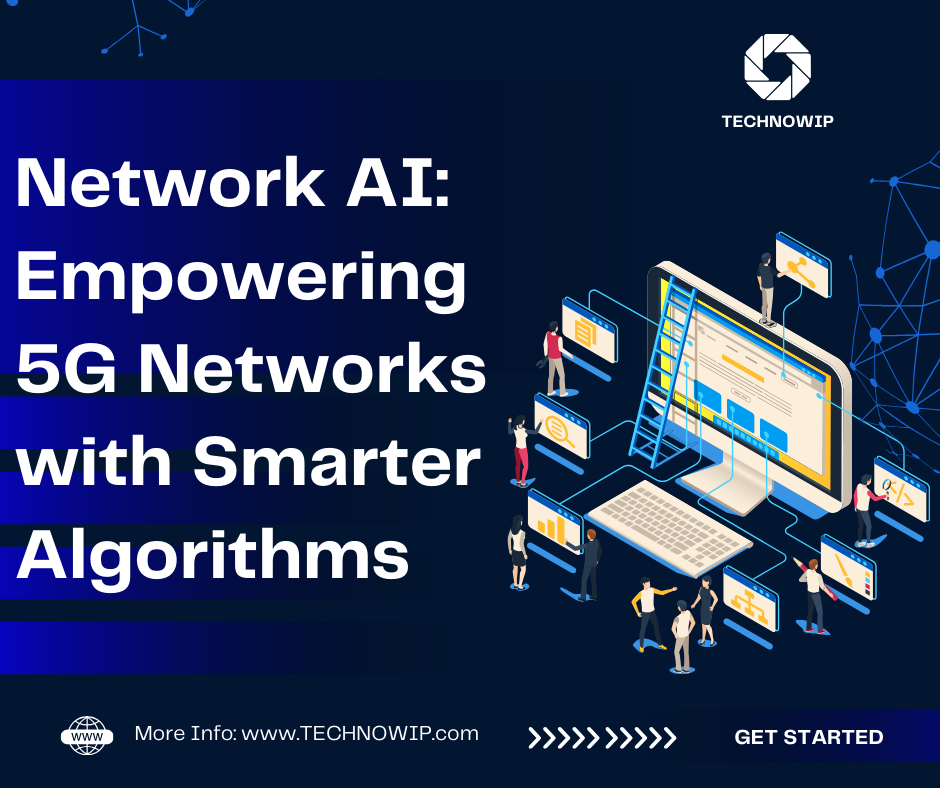Introduction
With 5G networks on the rise, providing faster speeds, lower latency, and efficient connectivity is no longer just an aspiration; it is now essential. Unfortunately, traditional approaches for managing networks fall short in reaching their full potential; Network AI uses advanced algorithms to enhance performance, predict network behavior accurately, and automatically resolve issues without human interference.
1. What is Network AI?
Network AI refers to the application of artificial intelligence technologies for optimizing and automating network operations. ML algorithms and predictive analytics help manage traffic volumes efficiently while allocating resources efficiently while anticipating issues proactively.
- AI in network management includes processes like network automation, resource allocation optimization and anomaly detection.
- Within 5G environments, Network AI manages large-scale device connections (like IoT devices ) while optimizing bandwidth allocation in real-time
2. Challenges 5G Networks Face Without AI
Although 5G networks promise faster data speeds and reduced latency, scaling them presents several obstacles: Massive data volumes: 5G devices produce massive amounts of real-time information which overwhelm traditional networks.
- Massive data volumes: 5G-enabled devices produce vast amounts of real-time data that overwhelm traditional networks.
- Network complexity: 5G networks support multiple technologies such as IoT, AR/VR, and autonomous systems, which need consistent and reliable connectivity.
- Latency issues: Achieving ultra-low latency across a wide network without automated management is almost impossible.
- Energy consumption: 5G networks need constant optimization to reduce the energy footprint.
3. How Network AI Empowers 5G Networks
AI can transform 5G networks through optimizing network slicing, predictive maintenance and dynamic bandwidth management to transform their operation and boost functionality. Here’s how AI empowers 5G:
a) Optimized Network Slicing
- AI algorithms use artificial intelligence (AI) algorithms to divide 5G networks into multiple slices optimized for specific services like IoT or streaming, allocating resources based on real-time demand.
b) Dynamic Traffic Routing
- Additionally, Dynamic Traffic Routing offers AI assistance so 5G networks can adjust traffic flow dynamically according to congestion patterns for improved user experiences.
- Predictive algorithms use historical trends to quickly evaluate usage trends and optimize routing paths automatically to reduce latency.
c) Energy Optimization
- AI-powered models detect areas with lower traffic volumes and power down unnecessary nodes to save energy consumption.
- Case studies demonstrate how AI-driven networks have reduced energy usage by 30-50% when deployed in real world deployments.
When I learned about AI’s ability to anticipate network congestion before it occurs, it struck me how proactive technology has become. For me personally, this seems like it gives the network its own sixth sense and stays one step ahead of potential issues.
4. Case Studies: How AI is Driving 5G Network Success
Real world implementations provide evidence for AI’s role in 5G networking success.
a) AT&T’s AI-Driven Network Management
- AT&T deployed AI-driven Network Management which allowed for improved bandwidth allocation during peak times by way of dynamic network management algorithms deployed using artificial intelligence algorithms.
- Results were 40% fewer network outages for customers and an uptick of 20% in data speeds.
b) SK Telecom’s AI-based Energy Efficiency
- SK Telecom implemented AI solutions to monitor network load and switch off idle components resulting in 35% cost reductions.
c) Vodafone’s Predictive Maintenance Using AI
- Vodafone implemented AI models to predict network failures early.
- Their result: downtime was decreased by 25% resulting in improved customer experiences and lower maintenance costs.
One of the greatest applications of Network AI is predictive maintenance. Imagine knowing your car will break down in two weeks’ time–that’s exactly what these algorithms do for networks! It is comforting knowing they can now prevent failures before they arise!
5. Key Benefits of Network AI in 5G Networks
a) Improved User Experience
- With AI solving network issues as they emerge in real time, customers experience smoother connectivity.
- AI also ensures seamless handovers between different networks, keeping video streaming and online gaming uninterrupted.
b) Lower Operational Costs
- AI can reduce operational costs for network operators by eliminating manual troubleshooting work – significantly cutting human intervention expenses as well as costs related to network maintenance costs.
- Real-time adjustments in traffic management enable more effective resource utilization.
c) Enhanced Security
- And real-time threat detection by Network AI provides real-time detection and prevention measures against threats before they affect users directly.
- Utilization of AI enabled firewalls prevent malicious activities before impacting them directly, further protecting us all.
AI-enhanced security gives me peace of mind. As data breaches become more frequent, knowing there’s technology actively protecting networks 24/7 makes me feel safer about how we stay connected.
6. Predictive Analytics: A Game-Changer for 5G Networks
- Predictive models utilize historical data to detect patterns in network behavior.
- AI algorithms can use this insight to detect failures, spikes in traffic or energy drain that might arise before issues emerge allowing timely preventative actions to take place before issues emerge.
- AI in 5G networks can predict when user data demand will spike and adjust bandwidth accordingly to avoid service disruption during peak hours.
I find AI mesmerizing; its capacity for pattern recognition astounded me. The network seems to know me better than I myself do and anticipates my data needs – this kind of intelligence sets modern networks apart.
7. Future Trends: Network AI and 5G Evolution
Networks AI is still making headway into 5G networks, yet several promising trends can already be observed:
- Artificially Intelligent self-healing networks could soon become popular by automatically detecting and correcting issues without human interference.
- Edge AI promises to process data closer to users and enhance real-time decision making, improving real time decision-making and providing autonomous networks that function without human oversight, handling everything from optimization to security management.
Thinking about autonomous networks makes me think of self-driving cars. It can be thrilling-and nervewracking–to imagine networks operating entirely by themselves–while at the same time demonstrating just how far technology has advanced.
8. Limitations and Risks of Network AI
Artificial intelligence offers many benefits; however it also comes with several risks: Biased Algorithms: If not trained appropriately, AI models could produce biased outcomes.
- Security Concerns: Hackers could potentially target these systems, necessitating robust security frameworks to keep hackers at bay.
- Implementation Costs Are Considered Exorbitant.
- Implementing AI into networks typically requires considerable investments both in terms of hardware and software.
AI may never reach perfection; that is fine with me; like every tool it has its limitations and weaknesses that must be considered when designing tools like AI. Finding an equilibrium requires striking the appropriate balance–leveraging its strengths while being aware of any challenges they present.
Trends
1. AI-Enhanced Healthcare through 5G Networks
AI and 5G technology allow doctors to conduct remote surgeries using autonomously operated robots controlled by AI algorithms, offering greater access to care in underserved regions as well as improving patient outcomes with AI-aided diagnostics.
2. Autonomous Vehicles and AI-Powered 5G Networks
Autonomous cars require real-time communication among their vehicle, surrounding infrastructure and other vehicles in real time to remain safe on the roads. AI is often utilized for tasks like decision-making, object recognition and path planning while 5G provides fast connectivity that ensures smooth interactions allowing self-driving cars to avoid collisions while simultaneously maintaining efficient traffic flow.

3. Edge Computing and AI for Real-Time Analytics
Edge computing brings data closer to its users rather than depending on distant cloud servers, using 5G networks for connectivity at the edge. AI technology then analyzes that data real time for businesses – retailers often utilize edge AI as part of a personal shopping experience with personalized offers based on real time customer behavior.
4. 5G and AI for Industrial Automation
In industrial settings, AI-powered robots and machines need fast connections in order to operate efficiently. 5G provides seamless data transfer while AI predicts maintenance needs thus improving uptime while decreasing costs, leading to greater productivity through optimized workflows and predictive analytics by Qualcomm.
5. AI-Driven Customer Experience in Retail
Retailers are using artificial intelligence over 5G networks to offer tailored product recommendations and interactive shopping experiences using Augmented Reality (AR). AI can analyze customer behavior in real time to create more tailored and enjoyable shopping experiences while opening the way to virtual assistants that deliver better customer service, reports TechRepublic.

6. AI and 5G for Smart Cities and IoT Integration
Smart cities rely heavily on IoT devices to collect and exchange data, with AI helping manage it to improve services such as traffic management, energy consumption management and public safety. 5G networks offer sufficient speed and connectivity for this AI-powered infrastructure to make urban spaces more efficient and sustainable.
7. Cybersecurity and AI in 5G Networks
AI provides cybersecurity by monitoring network behavior and detecting potential threats in real time, which prevents data breaches while assuring safe connectivity – this real-time threat detection becomes especially crucial as 5G expands with increasing numbers of connected devices and increases vulnerability points
8. Sustainability and Energy Efficiency through AI in Telecom
Telecom providers are increasingly turning to Artificial Intelligence (AI) algorithms for optimizing network energy consumption during periods of low demand, particularly AI algorithms that turn off idle nodes which reduce energy use and operational costs, in line with industry efforts toward sustainable network management (see Ericsson.com as an example of such efforts). This trend aligns with industry efforts towards sustainable network management ericsson.com.
9. AI-Enabled SLA Management and Network Automation
Service providers are using artificial intelligence (AI) to automate Service Level Agreement (SLA) management, providing seamless services without manual interventions or forecasts of potential issues or adjustments required in network configuration, thus mitigating dissatisfied customers and customer dissatisfaction ericsson.com.
10. Future Trends: Autonomous 5G Networks Powered by AI
The future of networking lies with autonomous 5G networks powered by artificial intelligence, where AI handles most operational tasks without human interference. Such networks will adapt their configuration in real time to address user experiences independently while solving issues on its own and creating better user experiences without human assistance. With advancement of this type of AI will come great cost reduction as well as enhanced reliability within telecom landscape – such as Qualcomm Ericsson Ericsson.com as an example.
9. Conclusion
AI technology is rapidly revolutionizing how 5G networks function, making them smarter, faster and more cost-efficient than ever. By automating processes, predicting network behavior and strengthening security features, AI ensures 5G networks meet their promises – something autonomous networks, edge computing and intelligent traffic management can take full advantage of as it becomes available to more applications.
FAQs about Network AI and 5G
What is Network AI?
Network AI refers to the application of artificial intelligence techniques for managing and optimizing networks.
How does AI help 5G networks?
AI automates network management, increases bandwidth allocation and decreases latency to optimize network efficiency and lower latency levels.
What is network slicing in 5G?
Network Slicing involves partitioning networks into virtual segments optimized for different services through AI-powered segmentation technology.
How does AI improve 5G energy efficiency?
AI can automatically switch off idle nodes to reduce energy usage by as much as 50%.
What is predictive maintenance in networks?
Predictive maintenance utilizes AI to anticipate network failures before they happen, providing predictive maintenance solutions before potential catastrophe strikes.
What are self-healing networks?
Self-healing networks utilize AI to automatically identify and resolve issues within themselves.
How does AI enhance network security?
AI detects and blocks threats immediately by recognizing abnormal network behavior.
What are the limitations of Network AI?
AI systems may be biased, expensive and subject to security threats.
How does AI enable autonomous networks?
Artificial Intelligence allows networks to operate autonomously – from optimization to security.
What are edge AI applications in 5G?
Edge AI processes data locally to maximize real-time responses and decrease latency.

